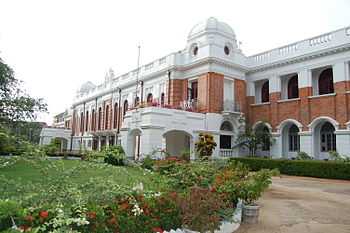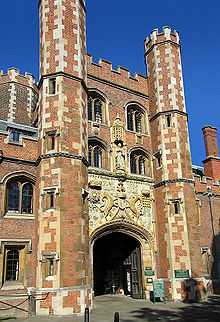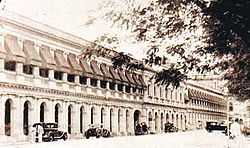James Peiris
| The Honourable Sir James Peiris JP | |
|---|---|
| | |
| Vice-President of the legislative council | |
| Personal details | |
| Born | 20 December 1856 |
| Died | 1930 |
| Nationality | Ceylonese |
| Alma mater | St John's College, Cambridge, Colombo Academy (Royal College, Colombo) |
| Occupation | Politics |
| Profession | Barrister |
| Religion | Christian |
Sir James Peiris (20 December 1856 – 1930), JP, was a prominent figure in the Sri Lankan independence movement and the first elected head (Vice-President) of the legislative council.
Early life and education


Born in Moratuwa on 20 December 1856 to T Martinus Pieris and Apolonia de Soysa,[1][2][3] a wealthy family who faced comparative poverty 15 years later along with the death of his father. Peiris was educated at the prestigious Colombo Academy (now Royal College, Colombo) where he excelled in studies winning the Turnour Prize and Shakespeare prize. He won the English University Scholarship in 1877 and proceeded to the St John's College, Cambridge at the University of Cambridge. At Cambridge he had the rare distinction of obtaining a double first – a first class in the Law Tripos and a first class in the Moral Science Tripos.[4] There he was the first non-European to be elected President of the Cambridge Union in 1882. Peiris was called to Bar at the Lincoln's Inn in England thus becoming a barrister. He refused to join the prestigious Ceylon Civil Service but instead started a law practice. In 1902 he accepted for a short time the office of District Judge of Galle. As a lawyer he played a great role in constitutional reform.[5]

Political career
As President of the Ceylon National Association (founded by Sir Charles Henry de Soysa), Peiris led the campaign to abolish the 'paddy (grain) tax' in 1893, for which he was recognised by the Cobden Club. He also campaigned to abolish the poll tax. Peiris's first entry into politics was as a Member of the Colombo Municipal Council from 1898 to 1908 representing the Slave Island ward, and served on the Public Works Council. Though a reluctant politician at first, Peiris initiated and proposed constitutional reforms such as the abolition of the then system of racial representation and the introduction of the elective principle in place of nomination.[6][7]
In 1915 Peiris led the campaign for a Royal Commission of Inquiry and the vindication of the reputations of those who had been falsely accused during the riots of 1915.[8] Peiris was the chairman of the committee which was protesting the British Governor's handling of the riots and the unfair and discriminative treatment being meted out to Sinhala Buddhist leaders. As a Christian, although he was offered privileges and pressured by the ruling British, he fearlessly refused them and stuck to his principles. Seeing the horror unleashed by the governor and his advisers, he initiated and drafted a memorandum in great secrecy supported by other prominent members of society including Sir Ponnambalam Ramanathan to bring it to the attention of the King and his majesties government. It was taken to England hidden in the sole of a shoe by E. W. Perera. As a result of this the governor Sir Robert Chalmers was recalled.[9]
In 1920 Peiris was elected President of the Ceylon National Congress staunchly supported by D.S. Senanayake and F.R. Senanayake.[10][11] He continued the struggle for reforms and promoted greater representation of natives in the government bureaucracy and the judiciary.[7]
There was wide support for Peiris' nomination to the Legislative Council of Ceylon. On two occasions when nominations had to be made for the position of "an educated Ceylonese" James Peiris was passed over. Many public meetings were held to support his nomination. There was no doubt that he enjoyed the confidence of the overwhelming majority of the educated Ceylonese. He was, however, never to be nominated to a position in the legislative council, notwithstanding his ability and integrity. Immediately the elective principle was introduced into the Legislative Council, Peiris was elected unopposed. In 1922 Peiris led the fight against the Supply Bill which sought to increase taxation and led a walkout from the Legislative Council in protest.[6]
The legislative council was reconstituted in 1924 with a majority of elected representatives. Peiris was elected as Vice-President – a position he held until his death in 1930. The post of President was held nominally by the Governor. Peiris accepted in 1925 a knighthood from the King and he was a Justice of the Peace for the whole island. He was the first Ceylonese occupant of Queens House as Acting-Governor.
He was first to propose the creation of a University College in Colombo and the means of financing it. Following the establishment of the University College, Colombo (later to become the University of Ceylon), Peiris was a Member of the Advisory Council of the new University College.[6]
Family & personal life
In 1889, Peiris married Grace de Mel daughter of Jacob de Mel and had 2 sons and 2 daughters: Ethel, Louise, Leonard and Devar Suriya Sena.[12][13] He was a devoted Christian and a standing committee member of the Church of England synod. He was a Fellow of the Colonial Institute, a President of the Sinhalese Sports Club, founding Secretary of the Royal College Union, member of the Orient Club, founder of the Ceylon Social Service League, the Ceylon Social Reform Association and the Cheshire Home.[6][14][15] He was an excellent horse rider.[15]
Legacy
Peiris is considered as one of the few distinguished Sri Lankan statesmen prior to its independence and is often referred to as the Father of Constitutional Reforms.[5] Those vindicated due to his efforts became the subsequent leaders of the nation. When his portrait was unveiled in Parliament, the then Prime Minister, S. W. R. D. Bandaranaike stated: "Like Moses, James Peiris brought his people within sight of the promised land, but did not live to see its fulfilment".[15] In his honour one of the major streets in Colombo is named Sir James Peiris Mawatha and so is Sir James Peiris Hall a Hall of Residence at the University of Peradeniya. The Sir James Peiris Memorial Prize is one of the prestigious prizes awarded annually at Royal College, Colombo.
See also
- List of Cambridge Union Society presidents
- Sri Lankan independence movement
- Sri Lankan independence activist
- Legislative Council of Ceylon
- George E. de Silva
Sources & External links
- THE LIFE AND CHARACTER OF SIR JAMES PEIRIS, by L.J.M. COORAY
- Sir James Peiris (1856–1930) Scholar, Orator, Lawyer and Statesman
- Life and times of Sir James Peiris
References
- ↑ Life of Sir James Peiris, W. T. Keble and Devar Surya Sena (University of California)
- ↑ Keyt's classics at Gothami Vihara, Sunday Observer (Sri Lanka), Retrieved 23 December 2014
- ↑ Yasodara in black, Ceylon Today, Retrieved 23 December 2014
- ↑ "Peiris, James (PRS878J)". A Cambridge Alumni Database. University of Cambridge.
- ↑ 5.0 5.1 Encyclopedia of Sri Lanka, by Charles A. Gunawardena, p.278 (Sterling Publishers Pvt. Ltd.)
- ↑ 6.0 6.1 6.2 6.3 Sir James Peiris (Public Life), by L.J.M. Cooray (Ourcivilisation Web), Retrieved on 28 November 2014
- ↑ 7.0 7.1 Working towards reform, The Sunday Times (Sri Lanka) Retrieved 23 April 2015
- ↑ The architects of independence in Sri Lanka By Shimazie Adjumain (The Ceylon Independent) Retrieved 01 March 2015
- ↑ Sri Lanka's Independence movement The Sunday Times. Retrieved 01 March 2015
- ↑ The Ceylon National Congress and its intrigues By K T Rajasingham, Asia Times Online,Retrieved 23 April 2015
- ↑ Chapter 18, Sri Lankan Tamil Struggle by T. Sabaratnam (Ilankai Tamil Sangam) Retrieved 01 March 2015
- ↑ A milestone for Gemunu By Lenard R Mahaarachchi The Sunday Times (Sri Lanka) Retrieved 23 December 2014
- ↑ Of Sri Lanka I sing The Sunday Leader Retrieved 23 December 2014
- ↑ OUR REVERED BENEFACTORS - SIR JAMES AND LADY PEIRIS (cheshirelanka.org) Retrieved 23 December 2014
- ↑ 15.0 15.1 15.2 Tales of a lifetime: A perfect gentle knight, The Island (Sri Lanka), Retrieved 23 December 2014